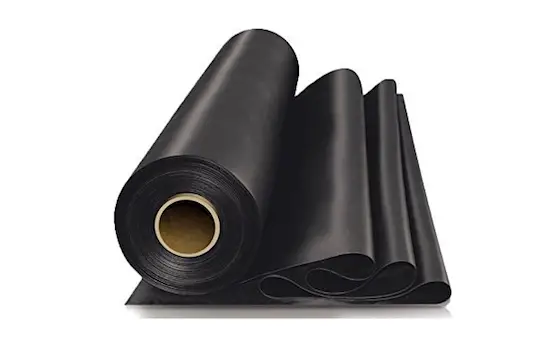Membrane Roofing Material
Membrane Roofing TIPS
- Thermoset membranes are the best
- Sun's rays will destroy all roofing
- Asphalt is the worst flat-roof material
- Create minimal slope - no flat roofs ever
- CLICK HERE to Get Tim's FREE & FUNNY Newsletter!
Flat and low-slope roofs have been around for ages.
Old technology dates back thousands of years with respect to deflecting water. Builders of old were no dummies and were quick studies when it came to keeping a structure dry.
Slope Is Everything
Look at old or ancient building roofs and one thing you'll quickly discover is the roofs have a great slope or pitch so water runs off fast.
Flat roofs, or those nearly flat, are problematic because water finds a way. Gravity and surface tension will pull it inside the smallest crack or crevice then you have a leak.
Sheet Metal Membranes
Once civilization figured out how to manufacture sheets of copper and other metals that can be soldered to create a membrane, or skin, then architects took advantage of this.
I used to work on many an old building in Cincinnati that had a low-slope tin roof.
I even had low-slope box gutters on the second home I owned. If installed correctly, these metal membranes will do a great job - for a while that is!
CLICK HERE to get FREE & FAST BIDS from local roofers who specialize in flat and low-slope roofs.
Asphalt
Old fashioned tar and pitch (asphalt compounds) were employed almost exclusively until 25 to 30 years ago. In fact, asphalt is still used today although its use is waning.
You might be able to locate a contractor that still applies hot tar to make a roof on a flat surface. They mop the tar onto felt paper and put in many layers. It's messy and it requires significant skill to create a leak-proof roof for any length of time.
Lumber Sag & Crown
Many flat roofs used to be built on top of wood structures. The wood can sag over time or the lumber itself is not consistent with respect to flatness.
Anything on the roof that works to create a low spot where water will puddle is death on a stick for a flat roof - no matter what the roofing membrane is.
Newer Synthetic Membranes
The new membrane products began to appear in the 1950's. The explosion in the synthetic rubber industry and the plastics industry helped fuel this growth.
The result are flat roofing products that enable you to basically "shrink-wrap" your roof!
Prior to the advent of these products, you knew that if you bought a building with a flat roof, dealing with leaks would be inevitable. The new membranes while much better than hot tar and asphalt, still had some growing pains.
Ultraviolet (UV) Light
One thing you need to understand about any roofing material, even a metal like copper, is the sun's UV rays are so powerful they blast apart atomic bonds.
The sun can break off copper ions from solid copper causing them to wash down to the oceans. This means that breaking the bond of a rubber membrane, or some other hybrid plastic/rubber membrane is child's play.
To slow this breakdown you need to put rock on the roof. Roofers call this ballast. The stones have a SPF rating of about 10,000 if you completely cover the membrane with the stones so no sunlight can reach the membrane.
Three Basic Types
There are three major types of flexible roofing membranes. All of them are fairly complex and some have names that you can barely pronounce.
I happen to like the products in the first group - those being the thermoset types.
CLICK HERE to get FREE & FAST BIDS from local roofers who specialize in flat and low-slope roofs.
Thermoset Membranes
These materials are ones that chemically crosslink. What that means to you is that once seams cure you have one giant molecule of roofing over your head and possessions.
That's a huge advantage. Many of the synthetic rubber roofs (EPDM) fall into this category.

This is my favorite membrane roofing material. If you need to put on a single-ply membrane, go for EPDM. It comes in wider rolls. CLICK THE IMAGE NOW TO BUY THIS MATERIAL.
You also find the CSPE, CR, and ECR compounds/membranes in this group. These membranes are fairly thick and often you will find them in thicknesses between 30 and 60 mils.
These roofing materials offer superior performance over a wide range of exposures. If applied according to manufacturers recommendations, they will give you leak-free performance for many, many years.
Thermoplastic Membranes
These membranes are very similar to the Thermosets, but there's no chemical cross-linking or vulcanization. Seams in the materials are welded together with solvents or heat.
The welds - when done properly - are as strong as the material.
PVC plastic materials are part of this group as well as the following materials:
- CPA
- CPE
- EIP
- NBP
- PIB
- TPO
These are "code" acronyms you might hear the roofer talk about. Be sure to ask exactly what type of material you are getting so you can see which group it falls into!
Modified Bitumen Membranes
These membranes combine asphalt with modifiers and reinforcement materials. They are often a "sandwiched" roofing material.
These materials can perform well in my opinion but they are not as advanced as the other two groups.
These materials are often referred to as "torch-down" roofs because a large flame throwing torch melts the asphalt so that seams can be joined together. You might hear your roofer mention the names APP or SBS when referring to this membrane.
These are my least favorite membrane roof. I guarantee you'll not get much leak-free service life if you use one.
CLICK HERE to get FREE & FAST BIDS from local roofers who specialize in flat and low-slope roofs.
Column B200
16 Responses to Membrane Roofing Material